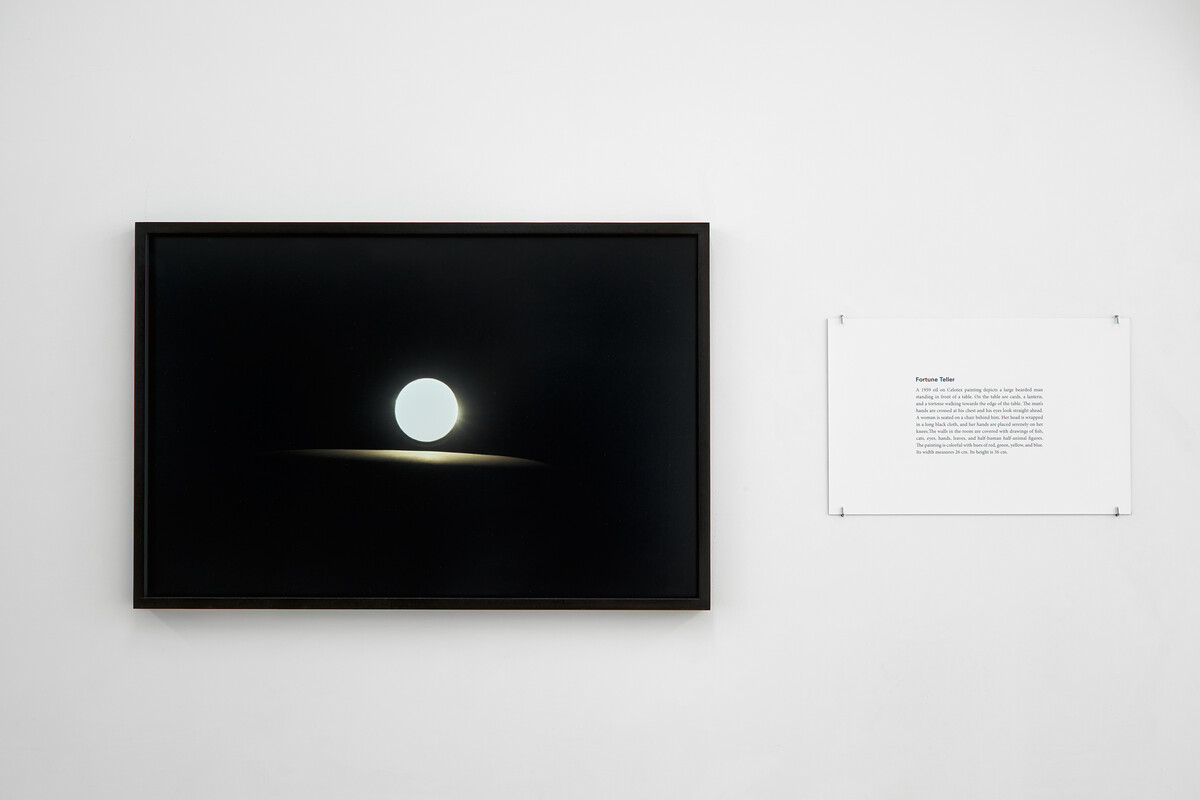March 14–May 23, 2015
What is the role of description in the way we talk about art? In art-historical discourse, iconography won out over formal analysis. The focus on line, color, and shape was replaced by the primacy of the subject matter. But more often than not, talking about art means talking about stuff in spaces, and so the first order of business is to describe what’s there: clarify what you’re talking about, then talk about its context. Description thus functions as a placeholder for the object, only unlike images and installation shots, description has agency and tacks meaning onto an artwork. Iman Issa’s exhibition “Lexicon” fields this process. “Lexicon” is a series of 13 displays, done between 2012 and 2014, in which Issa remakes historical artworks—drawings, oil paintings, lithographs—by presenting framed texts detailing the work she is responding to (which, despite the descriptions, always remain undisclosed) alongside new objects that reinterpret them.
What describes what? The relationship between the re-creations and the works they were born of is permeable. The titles of the original works are linked to—but not descriptive of—the pieces created by Issa: sculptures placed on white plinths, a video screening in the back office of the gallery, and framed prints. But the texts she writes describe something that isn’t present, objects never shown in the space. According to its text, Prayer (study for 2014) (2014), is a 1958 oil-and-ink painting on cardboard depicting a kneeling man. It reads, “Colors are limited to deep blues, blacks, and reds. Composition is symmetrical.” Next to it is a white metal sculpture on a whitewashed wooden plinth. It consists of a vertical metal bar that curves toward the wall in a 90-degree angle culminating in a small, flat, circular form. An LED light attached to the interior of the circle glows against the wall, producing a round aura. This white-on-white-on-white is far from recalling the deep blues, blacks, and reds of the painting described in the text; the metal does not bring up a human form like the one mentioned in the text. Yet the conflation of text and sculpture illuminates the words in the light of an object that doesn’t give much by way of subject at first glance, and it allows an abstract sculpture a sense of narrativity by its link to the historical work.
How to make sense of two things that seem to have little to do with each other? The two lenticular prints hanging side by side in Dancer (study for 2014) (2014) depict two iridescent, metal-colored empty Venn diagrams. How do they relate to the text on the wall that refers to a “1954 oil painting on canvas depict[ing] a female figure in the center of a round stage”? Text and images inform each other: thus what is described—a crowd whose features are abstracted, a dancer’s arms moving, her large hips—become the round shapes repeated in the prints, abstracting ideas into material. The text in Harvest (study for 2014) (2014) describes “two human figures in a golden-colored field” (a 1957 oil painting). Next to it is a video, presented on a flat screen, in which an abstract color gradation shifts slowly, almost seamlessly, from pink to orange, then green to a gray-ish blue, back to white and pink. Though the focus on light and color in both the painting and the video suggests a clear connection—the stuff of visual analysis: light, color, movement—it remains a suggestion.
What is the viewer’s role? The words used above—remake, revisit, recreate—are insufficient to describe the reconsidered relationship between language and object that Issa considers and complicates in her work. In “Lexicon,” the tone in Issa’s texts is flat, almost medical (“Forms are abstract and shapes are geometric,” in Mourning (study for 2013) [2013]; “the drawing has sharp lines and contrasting colors,” in Surrealism III (study for 2014) [2014]). But the titles of these works indicate their status as studies, which could be seen as a cop-out, as a relationship whose nature the artist is not ready to state clearly. That’s the work of the viewer: to link what is left open by the juxtaposition of texts and objects. The objects in Issa’s exhibition—as beautiful and attractive as they are—function as ideas, as an extension of this constantly reassessed relationship between language and material.
“Lexicon” was first shown at the 8th Berlin Biennale in 2014. Situated in a narrow room of the exhibition, it wasn’t as impressive as it is in the bright London venue. The multiplicity of 13 works allows for an expansion of Issa’s ideas, from the visual (Dancer as a study in movement, Harvest as an experiment in light) to abstracted notions (there are pieces about grief [Mourning (study for 2013), 2014], allure [Seduction (study for 2014), 2014], and devotion [Devotees (study for 2014), 2014]). The hanging relishes the architecture of the white exhibition space: beyond considering what the break between account and interpretation may mean, it also examines how standards of presentation can be emphasized in a way that actually further distances Issa’s work from accepted modes of display, where text explains object, where links are clearly aligned. “Lexicon” is an almost literary experiment: slowly chipping away at description, at an idea, arriving at a crossroads, and leaving the viewer there. The gap between description and object contradicts our expectations of an artist to build new links between things. Nothing is a given in “Lexicon,” and it’s work to make these connections. It’s rewarding, too.









